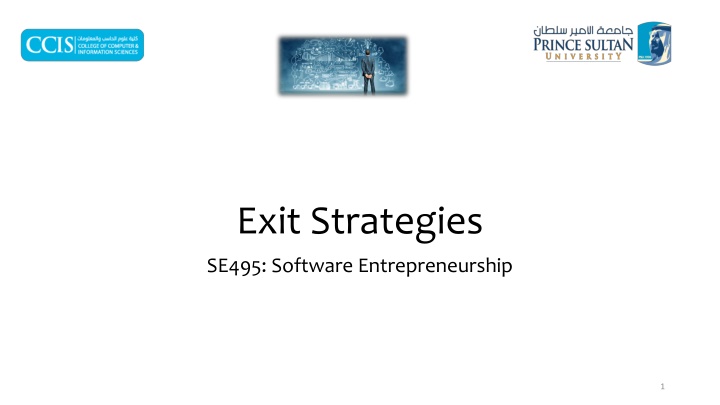
Sharing Advance Care Planning Documents in Massachusetts Public Meeting
This content covers a public meeting held in Massachusetts on December 7, 2017, focusing on sharing advance care planning documents. It includes agendas, overviews of MeHI (Massachusetts eHealth Institute), vision, mission, goals, and the coalition's mission to ensure personalized healthcare. The meeting addressed advance directives landscape, audience commentary, and emphasized the importance of training for clinicians in high-quality communication on advance care planning.
Download Presentation

Please find below an Image/Link to download the presentation.
The content on the website is provided AS IS for your information and personal use only. It may not be sold, licensed, or shared on other websites without obtaining consent from the author. If you encounter any issues during the download, it is possible that the publisher has removed the file from their server.
You are allowed to download the files provided on this website for personal or commercial use, subject to the condition that they are used lawfully. All files are the property of their respective owners.
The content on the website is provided AS IS for your information and personal use only. It may not be sold, licensed, or shared on other websites without obtaining consent from the author.
E N D
Presentation Transcript
Exit Strategies SE495: Software Entrepreneurship 1
Outline Introduction Types of Exit Strategies Factors to Consider When Choosing an Exit Strategy Preparing for an Exit Strategy Case Studies of Successful Exit Strategies 2
Introduction to Exit Strategies Exit strategies refer to the plans and strategies devised by startups to sell or transfer their ownership to another entity. It involves determining how and when the startup will exit the market, either through an acquisition, merger, initial public offering (IPO), or other means of transferring ownership. 4
Introduction to Exit Strategies Exit strategies are crucial for investors and founders to realize a return on their investment. Exit strategies can be categorized into two main types: Financial Strategic 5
Importance of Considering Exit Strategies Maximizing value for shareholders and founders Providing a clear roadmap Mitigating risks Attracting investors and strategic partners Facilitating succession planning 6
Overview of Different Types of Exit Strategies Financial exit strategies: Initial Public Offering (IPO) A company goes public and issues stocks to raise capital. Mergers and Acquisitions (M&A) A company is acquired by another business or investor. Venture Capital (VC) Exit A VC firm sells its stake in a company to another investor or through an IPO. 7
Overview of Different Types of Exit Strategies Strategic exit strategies: Partnership or Collaboration A company partners with another business to expand its offerings or reach new markets. Joint Venture A company creates a new entity with another business to jointly own and operate a specific project or business line. Spin-Off A company separates a part of its business into a new entity, which can be sold or taken public. 8
Factors to Consider When Choosing an Exit Strategy Company stage and size. Industry and market conditions. Financial performance and growth potential. Competition and market share. Legal and regulatory requirements. 9
Types of Exit Strategies Mergers and Acquisitions (M&A) Initial Public Offering (IPO) Strategic Partnerships Spin-Offs Liquidation 11
Mergers and Acquisitions (M&A) Refer to the process of combining two or more companies into a single entity. M&A can involve the acquisition of a company by another company, or the merger of two or more companies to form a new entity. M&A can be done for various reasons, including expanding market share, acquiring new technologies, increasing efficiency, and gaining access to new markets. 12
Advantages of M&A Increased market share and revenue Access to new technologies and intellectual property Cost savings through synergies and economies of scale Enhanced competitiveness and market position Diversification of products and services Access to new markets and customers 13
Disadvantages of M&A Integration challenges and cultural differences Risk of overpayment for the acquisition Potential loss of key employees and customers Difficulty in achieving expected synergies and cost savings Risk of negative impact on brand reputation and customer loyalty Potential legal and regulatory issues 14
Examples of Successful M&A Exit Strategies Microsoft's acquisition of LinkedIn for $26.2 billion in 2016 Salesforce's acquisition of ExactTarget for $2.5 billion in 2013 Oracle's acquisition of NetSuite for $9.3 billion in 2016 Symantec's acquisition of Blue Coat for $4.65 billion in 2016 IBM's acquisition of Red Hat for $34 billion in 2018 Zoom acquired Five9 for $14.7 billion in 2020 15
Initial Public Offering (IPO) The process of a privately held company raising capital by selling its shares to the public for the first time. IPO is a significant milestone for any company, as it allows the company to raise capital, increase its visibility, and attract new investors. IPO involves the issuance of new shares to the public, and the company receives the funds raised from the sale of these shares. 16
Advantages of IPO Access to capital Increased visibility Liquidity Enhanced credibility 17
Disadvantages of IPO High costs Time-consuming Loss of control Risk of dilution 18
Examples of Successful IPO Exit Strategies Microsoft's IPO in 1986, which raised $61 million and valued the company at $780 million. Google's IPO in 2004, which raised $1.67 billion and valued the company at $23 billion. Facebook's IPO in 2012, which raised $16 billion and valued the company at $104 billion. Uber's IPO in 2019, which raised $8.1 billion and valued the company at $80 billion. Airbnb's IPO in 2020, which raised $3.5 billion and valued the company at $112 billion. 19
Examples of Successful IPO Exit Strategies In 2022, Jahez, a Saudi food delivery and online marketplace, listed on the Tadawul through an IPO, raising SAR 1.1 billion (approximately USD 293 million). The IPO was oversubscribed by 205%. Nana plans to go public in the Saudi market in 2025 after raising SAR 500 million ($133 million) in funding to support its expansion plans across Saudi Arabia and neighboring countries, with the goal of capturing a larger share of the SAR 200 billion Saudi grocery market, where online sales are expected to grow significantly. 20
Acquisition vs IPO Pathways Feature Acquisition IPO To raise capital by selling shares of stock to the public Goal To grow by acquiring another company Process Complex and risky Challenging but can be rewarding The acquiring company gains control of the acquired company's assets, liabilities, and business operations The company's stock becomes more liquid and it has the capital it needs to grow Outcome 21
Acquisition vs IPO Pathways Feature Acquisition IPO To raise capital by selling shares of stock to the public Goal To grow by acquiring another company Process Complex and risky Challenging but can be rewarding The acquiring company gains control of the acquired company's assets, liabilities, and business operations The company's stock becomes more liquid and it has the capital it needs to grow Outcome 22
Acquisition vs IPO Pathways Acquisition: Pros: Higher Valuation Resources and Expertise Exit Opportunity Cons: Loss of Control Cultural Integration Merger Challenges 23
Acquisition vs IPO Pathways IPO: Pros: Liquidity and Fundraising Enhanced Visibility and Credibility M&A Currency Cons: Regulatory Compliance Market Volatility and Investor Scrutiny Loss of Privacy 24
Strategic Partnerships Refer to collaborative agreements between two or more businesses to achieve specific goals or objectives. These partnerships can be formed for various reasons, such as to access new markets, technologies, or customers, or to jointly develop new products or services. Strategic partnerships can be formal or informal, and can involve various levels of commitment and resource sharing. 25
Advantages of Strategic Partnerships Access to new markets, technologies, or customers Shared resources and costs Increased competitiveness and market share Improved product or service offerings Enhanced credibility and reputation Opportunities for joint research and development 26
Disadvantages of Strategic Partnerships Loss of control and autonomy Dependence on partners for success Potential conflicts and disagreements Difficulty in aligning goals and objectives Risk of intellectual property theft or misuse Potential for negative impact on brand reputation 27
Successful Strategic Partnership Exit Strategies Microsoft and Nokia's partnership to develop Windows Phone. Apple and Intel's partnership to develop the iPhone. Google and Android's partnership to develop the Android operating system. Amazon and BMW's partnership to integrate Alexa into BMW's vehicles. Salesforce and Microsoft's partnership to integrate Salesforce's CRM with Microsoft's Azure and Office 365. 28
Successful Strategic Partnership Exit Strategies Acquisition by a Local Conglomerate Uber's acquisition of Careem in 2019 for $3.1 billion, with a significant presence in Saudi Arabia. Strategic Sale to a Regional Player The sale of Saudi-based online retailer Souq.com to Amazon in 2017 for $580 million. 29
Spin-Offs A spin-off is a new company that is created by separating a part of an existing company, such as a business unit, product line, or technology. The existing company, known as the parent company, spin-offs the new company by transferring assets, employees, and intellectual property to the new entity. Spin-offs can be formed to focus on a specific market or technology, or to create a separate entity for a product or service that is not core to the parent company's business. 30
Spin-Offs Spin-offs can offer several Spin-offs can also have some advantages, including: disadvantages, including: Focus Risk Increased value Lack of scale Autonomy Dependence on parent company Attractiveness to investors Difficulty in attracting talent 31
Examples of Successful Spin-Off Exit Strategies Google's spin-off of Calico, a life sciences company focused on aging and longevity. Apple's spin-off of Beats Electronics, a audio products company. Amazon's spin-off of AWS, a cloud computing platform. Microsoft's spin-off of LinkedIn, a professional networking platform. Oracle's spin-off of NetSuite, a cloud-based business management software company. 32
Examples of Successful Spin-Off Exit Strategies Carve-Out of a Specific Product or Service Line Saudi Telecom Company's (STC) carve-out of its data center business into a separate entity, STC Data Centers. Spin-Off of a Research and Development (R&D) Unit King Abdullah University of Science and Technology (KAUST)'s spin-off of its R&D unit, KAUST Innovation, into a separate entity. 33
Liquidation The process of selling off a company's assets, such as property, equipment, and intellectual property, to convert them into cash or pay off debts. Liquidation can be voluntary, where the company chooses to liquidate its assets, or involuntary, where a court or creditor forces the company into liquidation. Liquidation can be used to wind up a company's operations, pay off debts, or distribute assets to shareholders. 34
Liquidation Liquidation can offer several Liquidation can also have some advantages, including: disadvantages, including: Quickly converting assets into cash Loss of control Reducing debt Limited return Closing down operations Negative impact on employees Distribution to shareholders Negative impact on reputation 35
Examples of Successful Liquidation Exit Strategies Microsoft's liquidation of its smartphone business, which allowed the company to focus on its core software business. Yahoo's liquidation of its core internet business, which resulted in a successful exit for shareholders. Hewlett-Packard's liquidation of its webOS business, which allowed the company to focus on its core hardware and software businesses. IBM's liquidation of its PC business, which allowed the company to focus on its core software and services businesses. 36
Factors to Consider When Choosing an Exit Strategy 37
Factors to Consider When Choosing an Exit Strategy Company goals and objectives Market conditions Financial performance Competitive landscape Team dynamics and considerations 38
Company Goals and Objectives Importance of aligning exit strategy with company goals and objectives Examples of company goals and objectives that may influence exit strategy: Revenue growth Market share Innovation Customer satisfaction Financial performance 39
Market Conditions Importance of considering market conditions when choosing an exit strategy Examples of market conditions that may influence exit strategy: Market size and growth potential Competition Customer needs and preferences Technological advancements Economic conditions 40
Financial Performance Importance of financial performance in choosing an exit strategy Examples of financial metrics that may influence exit strategy: Revenue Profitability Cash flow Valuation Return on investment (ROI) 41
Competitive Landscape Importance of considering the competitive landscape when choosing an exit strategy Examples of factors that may influence exit strategy: Number of competitors Competitor size and strength Competitor market share Competitor pricing and product offerings Barriers to entry 42
Team Dynamics and Considerations Importance of considering team dynamics and considerations when choosing an exit strategy Examples of team dynamics and considerations that may influence exit strategy: Team size and structure Employee retention and turnover Team expertise and skills Team alignment with company goals and objectives Employee ownership and equity 43
Preparing for an Exit Strategy Building a strong management team Developing a clear growth strategy Ensuring financial stability Enhancing the company's valuation Preparing for due diligence 45
Building a Strong Management Team Importance of having a strong management team in place Reasons why a strong management team is critical for a successful exit: Attractiveness to potential buyers Ability to execute on growth plans Increased valuation 46
Building a Strong Management Team Tips for building a strong management team: Hire experienced and skilled professionals Develop a clear organizational structure Provide training and development opportunities Foster a positive company culture 47
Developing a Clear Growth Strategy Importance of having a clear growth strategy in place Reasons why a clear growth strategy is critical for a successful exit: Provides direction and focus for the company Demonstrates potential for future growth Increases valuation Tips for developing a clear growth strategy: Conduct market research and analysis Identify key growth drivers Set realistic and achievable goals Develop a plan for executing on the growth strategy 48
Ensuring Financial Stability Importance of ensuring financial stability Reasons why financial stability is critical for a successful exit: Attractiveness to potential buyers Ability to execute on growth plans Increased valuation Tips for ensuring financial stability: Develop a solid financial plan Manage cash flow effectively Reduce debt and liabilities Build a strong financial team 49
Preparing your company for acquisition Financial Planning: Accurate and Up-to-Date Financial Statements Clean Up Financial Records Financial Projections 50






















